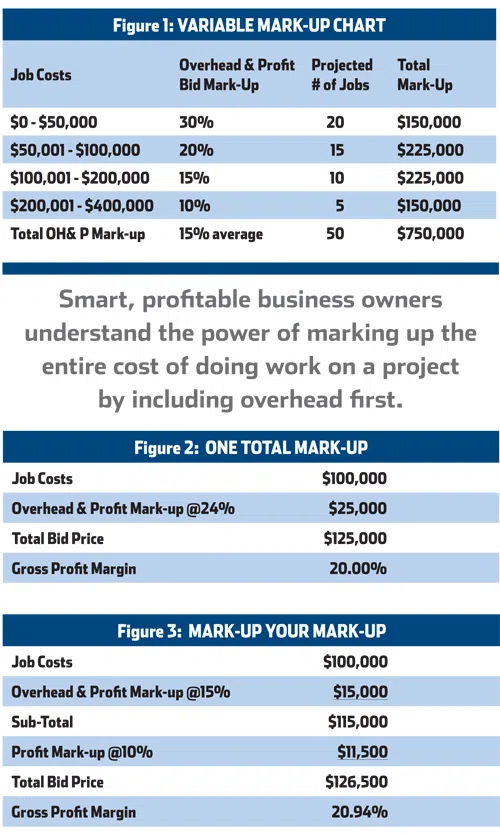Taking pride in your company's awesome service and workmanship is one thing, but getting paid more than your competition for better quality is another.
Every service company, professional, engineer, contractor, subcontractor, and builder I’ve ever met boasts that their company’s quality and service is superior to the competition. If true, this is a great thing, but after you present your proposal and the excitement settles down, what really matters? PRICE!
Ask yourself this question: Do my customers pay me more than my competition for the same work?
To get paid more, you must offer more. Most companies want to sell quality over price, but they really don’t offer any more than their competitors. A contract normally is awarded based on bidding lump sum for the minimum required per the project specifications, plans, and customer’s project requirements. When preparing a proposal, estimate, or bid, most companies never consider including more than the minimum required. Why? They’ve got to be low bidder to get the work!
Imagine living in a world where customers, clients, project owners, developers, builders, and homeowners actually pay more for quality work and excellent service. I took an interesting survey while speaking at a Construction Owners Association of America (COAA) convention. COAA is composed of organizations and companies that regularly engage in building major construction projects as the owner or developer. During my presentation, I asked these attendees to tell me how much quality and service matters when selecting architects, engineers, contractors, subcontractors, suppliers, or maintenance companies. The results were not what I regularly experience in the real world.
Ninety-five percent of these project owners stated that quality and service matter when selecting their service providers, suppliers, and contractors; and 89 percent said they will and do pay more for better quality and service! I found this astonishing. As a general contractor, when I bid or propose on most projects, the contract award is primarily based on the lowest bidder.
How much more will building owners and developers pay for quality workmanship?
- 36 percent will pay 1 – 4 percent more,
- 36 percent will pay 5 percent more,
- 18 percent will pay 10 percent or more, and
- ONLY 10 percent will NOT pay more!
How much more will building owners and developers pay for good service?
- 38 percent will pay 1 – 4 percent more,
- 29 percent will pay 5 percent more,
- 17 percent will pay 10 percent or more, and
- ONLY 16 percent will NOT pay more!
Most general contractors, subcontractors, and suppliers are proud of their quality of work, reputation, and personal service. But today’s financial demands, project complexities, and tight schedules require project owners and developers to often look for more than a low bid. If they aren’t aware of the added value or quality workmanship you offer, however, the buyer has no choice but to evaluate and select based on price.
The bottom line — four out of five say they will pay more for better quality and service! How much more and when depends on each customer, project, and property. In order to sell quality over price, you must determine specifically what your customer wants on every project you bid on. Focus on the important issues that make a difference by asking before you bid, and then address it in full detail in your proposal.
7 Ways To Sell More Than Price
1. Build trusted relationships by getting in front of customers: Most customers buy based on a perception of value and trust. If your company is perceived as a company that provides exceptional quality and on-time work, it will easily get on lots of bid lists. And when you are the lowest bidder, you should get lots of competitive work to build. Over time, success will be determined more by your reputation than price.
Remember that your ultimate goal is building long-term relationships with people so that they become loyal customers. You will do this by demonstrating that your most valuable asset is trust versus just sticks and stones.
At first, the purpose of your bid or proposal is to get in front of your customer. Then, as you start to do quality work for them, you can get to know them personally during project interactions, plus taking them out to breakfast, lunch, industry meetings, or ballgames on a regular basis. Take your top 10 customers out at least every two to three months. The only way to create trusted, deeply loyal relationships is to spend face-to-face time with customers in a fun or relaxed atmosphere. As with friends, building trust takes lots of quality time.
2. Be the "select" bidder: Leading companies are known for being the best at something. Some are known for project types, or difficult jobs, or fast-track schedules, or design-build, or detailed quality workmanship. People will pay more for the best. To be the best, your customer must know what you specialize in. Let them know and tell them again and again. Use press releases, articles, photos, or brochures. Send them something often and constantly — at least every three months. Why is Nordstrom known for customer service? They tell their customers all the time!
When you’re known as the best in your market for the type of projects you specialize in, your company will get the first chance to propose, and the last chance to match, the price needed. Experts get the great jobs at their prices. Generalists get the leftovers when their price is the cheapest. What are you known for? What are you the best at? Do your potential customers know? If I visited your town looking for the type of quality work you specialize in, would your company get the only referral?
3. Get on the right proposal and bid lists: Before you sell quality over price, determine what type of work your company wants to do, and for what type of customers. At Hedley Construction, we determined our best customers were developers who needed full service construction and development project management, from initial concept and feasibility, to working drawings and permits, to construction and completion. These customers need what we offer, and don’t mind paying for full service. Eliminate customer targets who just want a low bid and don’t give you credit for extra quality and professional service.
Create a "bid-grid-sieve" to determine if and what you will bid. Include these factors:
- Repeat business potential
- Profit potential
- Project type
- Project location
- Project size
- Project profit
- Competition
One excellent strategic decision our company made was to stop trying to be all things to all customers. When we developed our bid-grid-sieve we decided to stop bidding and only negotiate projects; make it our goal to primarily work for repeat customers and try to convert them to loyal customers who will use only us to build their projects; specialize in a limited number of project types; work only within a 60-mile radius; target a minimum project size; work only on projects with a minimum profit margin; and propose only on projects with a maximum of two or three competitors. With this narrow focus, we now concentrate our efforts on the right projects and customers who we can create trusted relationships with.
4. Offer more than low price: As a builder, we bid and price out several jobs every month. For each project, we receive about 100 subcontractor bids for the 30 sub-trades usually required. On average, less than 10 percent of these bidders ever call us to present their bid, review their proposal, discuss their bid, or even to meet with us for any reason. When we don’t hear from our valued subcontractors or suppliers, we assume they don’t have more to offer than a low price based on the minimum required per plans and specifications. And when they finally do call, they ask only: "How do I look?" which translates: "Is my price too high?" or "How much do I need to cut?"
Every project has different needs. Sometimes price is the only differentiating factor, but how will you know what really matters to your customer without asking before you bid? On most projects price is not the only determining factor. On many projects, subcontractors are weighed heavily based on specific factors like: schedule, quality, safety, professionalism, technical skills, cleanliness, financial capacity, manpower, or responsiveness. But when all we get is a faxed or handwritten bid proposal, we don’t know if they intend to help us meet our project goals.
Before bidding every project, ask your customer:
- What do you want most from us?
- What are your most critical problems?
- How can we help reduce your risk?
- What will help you award this contract to us?
- What else can we do for you?
Include solutions to these questions in your proposal and presentation. Always try to deliver your bid in person, and present it in a visual and convincing way so your customer will see and believe your company has the answers to their problems. Use photos of the project site and similar projects you have worked on that depict the similar challenges and concerns. Also use bar charts, samples, a proposed schedule, material brochures, flip charts with lists, or project photos. The better you look, the better you’ll look.
5. Be a squeaky wheel: Estimators are more than price givers. They are in the sales business and need to spend lots of time with customers. Be in the right place at the right time by being in your customer’s office or home every week during the bidding process to show you want the job more than your competitor does. Stop by, ask lots of questions, offer ideas on how to make their project better, provide alternative suggestions, and look for ways to help your customer.
After the bid presentation, follow it up aggressively, and in person. Estimating and preparing the bid is only half the work. To sell more than low price and present your quality workmanship, you must do more than fax in your bid. Go see your customer and bug them until they buy or die! Bids don’t sell, people do.
6. Remember that your price is NOT too high: Be confident in your company and what it has to offer. When customers tell you your price is too high, always answer: "No, it’s not," then patiently wait for them to speak the next words. They will always tell you something you can comment on in a positive or creative manner. If you quickly respond with "No, we’re not too high," and don’t wait to hear what your customer has to say, you start an argument you’ll lose. Let them talk first, listen, and look for ways to offer suggestions to improve your position.
Ask them the same questions we discussed earlier, and look for ways to help them reach their goals and use your company to build their project. You may have to give and take a little on price to get the job, but without a conversation, you have no chance.
7. Always ask for the order: Most bids and presentations end without the presenter asking for the order. When you don’t ask, the answer is "No!" Get in the habit of asking these tough questions:
- Will you negotiate?
- Who else is bidding?
- Who have you used before?
- How will you review the proposals?
- What is the contract selection criteria?
- What is the most important selection criteria?
If all else is equal, what are the chances we have to be awarded the job?
Selling quality takes persistence, discipline, and determination. The tendency is to get caught up in the price game. The first question is always "How much?" People buy price once and live with quality forever. Your job is to remind them of this over and over and not let them forget what you have to offer.
Never assume by doing good work you will get the next job at your price. Try implementing these seven ideas, sell more than price, and see your bottom-line improve.

 George Hedley is the best-selling author of "Get Your Construction Business to Grow & Profit!" available at his online bookstore. As an entrepreneur, popular speaker and business coach, he helps business owners build profitable companies.
George Hedley is the best-selling author of "Get Your Construction Business to Grow & Profit!" available at his online bookstore. As an entrepreneur, popular speaker and business coach, he helps business owners build profitable companies.
E-mail: gh@hardhatpresentations.com to request your free copy of "Business Tools To Boost Your Bottom-Line!" or sign up for his free monthly e-newsletter. To hire George, attend his "Profit-Builder Circle" boot camp or be a part of an ongoing "Executive Roundtable Peer Group" call 800-851-8553 or visit www.hardhatpresentations.com.



 George Hedley is the best-selling author of "Get Your Construction Business to Grow & Profit!" available at his online bookstore. As an entrepreneur, popular speaker and business coach, he helps business owners build profitable companies.
George Hedley is the best-selling author of "Get Your Construction Business to Grow & Profit!" available at his online bookstore. As an entrepreneur, popular speaker and business coach, he helps business owners build profitable companies. 
